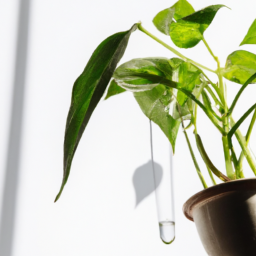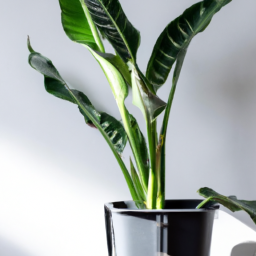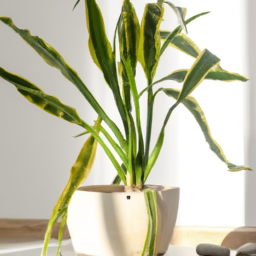
If you’ve ever tried to keep indoor plants thriving, you know that they require more than just water and soil. One crucial factor that often gets overlooked is proper lighting. Whether you’re a seasoned plant parent or just starting your green thumb journey, understanding the basics of indoor plant lighting is essential to ensure your plants receive the light they need to thrive. In this blog post, we will explore the different aspects of indoor plant lighting, from the types of light to the duration and intensity required for optimal growth. So, let’s delve into the world of indoor plant lighting and discover how to create the perfect environment for your leafy companions.
Understanding the Different Types of Indoor Plant Lighting
When it comes to indoor gardening, providing the right amount and type of lighting is crucial for the health and growth of your plants. Understanding the different types of indoor plant lighting available will help you make informed decisions to create the optimal environment for your indoor garden. In this guide, we will explore the basics of indoor plant lighting, including natural light, artificial light, and the different types of artificial lighting options available.
Natural Light
Natural light is the most common and readily available source of light for indoor plants. It is free, abundant, and provides a full spectrum of light that plants need for photosynthesis. However, the availability and intensity of natural light can vary depending on factors such as the time of year, location, and the direction your windows face.
When positioning your plants near a window, consider the intensity and duration of sunlight they will receive throughout the day. South-facing windows generally provide the most intense light, while east and west-facing windows offer moderate intensity. North-facing windows receive the least amount of light and may not be suitable for plants with high light requirements.
It’s important to note that even with natural light, certain plants may still require supplemental artificial lighting, especially if they are placed far from windows or in rooms with limited natural light.
Artificial Light
Artificial lighting is an excellent option for indoor gardening, especially when natural light is limited or unavailable. It allows you to provide consistent and controlled lighting conditions for your plants, ensuring they receive the necessary light energy for photosynthesis.
When choosing artificial lighting for your indoor garden, there are three main types to consider: fluorescent, LED, and high-intensity discharge (HID) lights.
Fluorescent Lights
Fluorescent lights are a popular choice for indoor gardening due to their affordability and versatility. They come in two main types: compact fluorescent lights (CFLs) and T5 fluorescent lights.
CFLs are energy-efficient and produce a wide spectrum of light suitable for most plants. They are available in various wattages and color temperatures, allowing you to choose the right combination for your plants’ specific needs. CFLs are commonly used for seedlings, herbs, and low to medium light plants.
T5 fluorescent lights, on the other hand, are more powerful and efficient than CFLs. They produce a higher light output and are suitable for larger plants or those with higher light requirements. T5 lights are often used for growing vegetables, flowering plants, and tropical plants that need high-intensity lighting.
Both CFLs and T5 fluorescent lights require fixtures or reflectors to maximize light distribution and efficiency. They should be positioned close to the plants, typically within 2-6 inches, to ensure adequate light penetration.
LED Lights
LED (Light Emitting Diode) lights have gained popularity in recent years due to their energy efficiency, long lifespan, and versatility. LED lights are available in a wide range of colors and can be customized to provide specific light spectrums tailored to different stages of plant growth.
LED lights produce little heat, allowing them to be placed closer to plants without the risk of burning foliage. They are also more durable and require less maintenance compared to other lighting options. LED lights are suitable for a wide range of plants, from seedlings to flowering plants, and can be used as the sole light source or in combination with natural light.
High-Intensity Discharge (HID) Lights
HID lights are the most powerful and suitable for large indoor gardens or plants with high light requirements. There are two main types of HID lights: metal halide (MH) and high-pressure sodium (HPS) lights.
MH lights emit a bluish-white light spectrum, which is ideal for promoting vegetative growth. They are commonly used during the early stages of plant growth or for leafy greens and herbs. HPS lights, on the other hand, emit a reddish-orange light spectrum that promotes flowering and fruiting. They are often used during the flowering stage or for plants that require high light intensity.
HID lights produce a significant amount of heat and require proper ventilation and cooling to prevent damage to plants. They also consume more energy compared to fluorescent or LED lights. Due to their high intensity, HID lights should be positioned at a suitable distance from the plants to avoid burning or light stress.
Now that you have a better understanding of the different types of indoor plant lighting, you can choose the right lighting option for your indoor garden. Remember to consider the specific light requirements of your plants and adjust the lighting conditions as needed throughout their growth stages. With the right lighting, your indoor plants will thrive and beautify your living space.

The Basics of Indoor Plant Lighting
2. Choosing the Right Light Spectrum for Indoor Plants
Indoor plants require proper lighting to thrive and grow. One crucial aspect of indoor plant lighting is choosing the right light spectrum. Different light spectrums have varying effects on plants, and understanding these effects will help you provide the best lighting conditions for your indoor plants. In this article, we will guide you through the basics of choosing the right light spectrum for indoor plants.
Understanding Light Spectrum
Light spectrum refers to the range of wavelengths emitted by different light sources. It is commonly measured in nanometers (nm) and consists of various colors such as red, blue, green, and others. Each color within the spectrum has a different impact on plant growth and development.
When it comes to indoor plants, two primary light spectrums are essential: red light (wavelengths around 600-700nm) and blue light (wavelengths around 400-500nm). These colors are crucial for photosynthesis, the process by which plants convert light energy into chemical energy to fuel their growth.
Red light is responsible for promoting flowering and fruiting in plants. It stimulates the production of chlorophyll and other pigments necessary for photosynthesis. On the other hand, blue light plays a vital role in vegetative growth, influencing leaf development, stem elongation, and overall plant size.
Choosing the Right Light Spectrum
Now that we understand the importance of red and blue light, let’s explore how to choose the right light spectrum for your indoor plants:
1. Full Spectrum Lighting: Full spectrum lighting provides a balanced combination of red, blue, and other colors across the entire light spectrum. This type of lighting mimics natural sunlight and is ideal for most indoor plants. It ensures healthy growth, supports photosynthesis, and promotes overall plant development. Full spectrum LED grow lights are a popular choice among indoor gardeners due to their energy efficiency and long lifespan.
2. Red and Blue LED Lights: If you have specific plants that require more red or blue light, you can opt for LED lights that focus on these colors. Red LED lights are beneficial for flowering and fruiting plants, while blue LED lights are suitable for plants in the vegetative stage. By using specific LED lights, you can tailor the light spectrum to meet your plants’ exact needs.
3. Supplemental Lighting: In some cases, natural light may not be sufficient for indoor plants, especially during winter or in rooms with limited sunlight. Supplemental lighting can be used to provide additional light and ensure optimal growth. You can use fluorescent lights, compact fluorescent bulbs, or high-intensity discharge (HID) lamps as supplemental lighting sources. However, it’s crucial to monitor the distance between the light source and plants to prevent heat damage.
Implementing the Right Light Spectrum
Once you have chosen the appropriate light spectrum for your indoor plants, it’s essential to implement it correctly. Here are some tips to ensure optimal lighting:
1. Positioning: Place the light source at an appropriate distance from the plants. The distance may vary depending on the light intensity and the specific plant’s light requirements. As a general guideline, keep the light source 6-12 inches above the plants for LED lights and adjust accordingly based on plant response.
2. Duration: Indoor plants require a certain number of hours of light exposure each day. Most plants need around 12-16 hours of light per day for optimal growth. However, it’s important to research the light requirements of your specific plant species, as some may have different needs.
3. Light Intensity: Different plants have different light intensity requirements. Some plants thrive in high-intensity light, while others prefer lower light levels. Adjust the light intensity based on the plant’s natural habitat and light requirements. You can use a light meter to measure the light intensity and ensure it falls within the recommended range.
By following these steps and understanding the basics of choosing the right light spectrum for your indoor plants, you can create an optimal environment for their growth and ensure healthy, thriving plants. Remember to regularly assess your plants’ response to the lighting conditions and make necessary adjustments to provide the best care.

Essential Factors for Effective Indoor Plant Lighting
Introduction
Indoor plants not only add beauty to our living spaces but also offer numerous health benefits. To ensure their well-being and growth, providing them with proper lighting is essential. In this guide, we will explore the basics of indoor plant lighting and discuss the essential factors that contribute to effective lighting for your plants.
Understanding Light for Plants
Plants rely on light for photosynthesis, the process through which they convert light energy into chemical energy, enabling them to grow and thrive. When it comes to indoor plants, replicating natural sunlight is crucial. However, not all light sources are equal in terms of their effectiveness for plant growth.
The Role of Intensity
The intensity of light refers to the brightness or strength of the light source. Different plants have varying light intensity requirements, and it is crucial to understand these needs to provide optimal conditions. Low-light plants, such as ferns or snake plants, can thrive in areas with lower light intensity, while high-light plants, like succulents or cacti, require intense light to flourish.
It is important to note that the intensity of light decreases as the distance from the source increases. Therefore, it is necessary to position your plants at an appropriate distance from the light source to ensure they receive the required intensity.
The Significance of Duration
Apart from intensity, the duration of light exposure also affects plant growth. Plants require a balance between light and darkness to simulate their natural environment. While some plants thrive with longer exposure to light, others need a period of darkness for proper growth. Understanding the specific light duration requirements of your plants is crucial to their overall health and development.
Choosing the Right Light Spectrum
The light spectrum refers to the range of different wavelengths of light emitted by a light source. Plants primarily utilize two types of light for photosynthesis: blue light and red light. Blue light promotes vegetative growth, while red light stimulates flowering and fruiting.
To provide your indoor plants with the right light spectrum, consider using full-spectrum LED grow lights. These lights emit a balanced combination of blue and red light, closely resembling natural sunlight. Full-spectrum LED lights are energy-efficient, long-lasting, and can be adjusted to meet the specific needs of your plants.
Positioning and Distance
Proper positioning and maintaining the right distance between your plants and the light source are crucial for effective indoor plant lighting. Placing the light source too close can result in excessive heat, which can damage the plants. On the other hand, positioning the light too far away may not provide sufficient intensity for growth.
As a general rule, high-light plants should be positioned closer to the light source, while low-light plants can be placed further away. Regularly monitor the plants for any signs of stress or stretching, which may indicate inadequate light exposure or incorrect positioning.
Supplementing Natural Light
While natural sunlight is the best light source for plants, it may not always be available or sufficient, especially for indoor plants. In such cases, supplementing natural light with artificial light sources becomes necessary. LED grow lights are a popular choice due to their energy efficiency and ability to provide the required light spectrum.
When supplementing natural light, consider the specific needs of your plants and adjust the lighting accordingly. It is advisable to provide a combination of natural and artificial light to ensure optimal growth and health.
Conclusion
Understanding the basics of indoor plant lighting is essential for any plant enthusiast. By considering factors such as light intensity, duration, spectrum, positioning, and supplementation, you can create the ideal lighting conditions for your indoor plants. Remember to regularly assess your plants’ response to the lighting and make necessary adjustments to ensure their continued well-being. With proper lighting, your indoor plants will thrive and bring beauty and vitality to your living spaces.
Here are the Essential Points
Indoor plants are a great way to bring life and greenery into your home, but they require proper lighting to thrive. Understanding the basics of indoor plant lighting is essential for ensuring your plants receive the right amount of light to grow and flourish.
Firstly, it’s important to know that different plants have different lighting requirements. Some plants, like succulents and cacti, prefer direct sunlight and need to be placed near a south-facing window. On the other hand, plants like ferns and snake plants can thrive in low-light conditions and can be placed further away from windows.
When it comes to artificial lighting, there are various options available. The most common types are fluorescent lights and LED grow lights. Fluorescent lights are affordable and provide a good source of light for most indoor plants. On the other hand, LED grow lights are more energy-efficient and can be adjusted to provide the specific light spectrum that plants need for photosynthesis.
In conclusion, understanding the basics of indoor plant lighting is crucial for the health and growth of your indoor plants. By considering the specific lighting requirements of different plants and choosing the right artificial lighting, you can create an ideal environment for your plants to thrive and bring beauty to your home.
Here are this week’s Top Questions and Answers
Q1: What is the importance of indoor plant lighting?
A1: Indoor plant lighting is crucial because it provides the necessary energy for plants to carry out photosynthesis, the process by which they convert light into energy. Without proper lighting, plants may struggle to grow, develop weak stems, have pale leaves, or even die.
Q2: What are the different types of indoor plant lighting?
A2: There are primarily three types of indoor plant lighting: natural light, fluorescent lights, and LED grow lights. Natural light is the sunlight that enters through windows, while fluorescent lights are commonly used for low to medium light plants. LED grow lights, on the other hand, are specifically designed to provide the full spectrum of light that plants need for optimal growth.
Q3: How much light do indoor plants need?
A3: The amount of light required by indoor plants varies depending on the type of plant and its natural habitat. Generally, most indoor plants thrive in bright, indirect light. However, it’s important to research the specific light requirements for each plant species to ensure they receive the right amount of light for healthy growth.
Q4: How can I determine if my indoor plants are getting enough light?
A4: There are a few signs to look out for to determine if your indoor plants are receiving adequate light. If your plants have elongated stems, pale or yellowing leaves, or if they are leaning towards the light source, it may indicate that they are not getting enough light. On the other hand, if your plants have burnt or scorched leaves, it could be a sign of excessive light exposure.
Q5: How can I supplement light for indoor plants?
A5: If your indoor plants are not receiving sufficient natural light, you can supplement it with artificial lighting. LED grow lights are a popular choice as they provide the full spectrum of light that plants need for healthy growth. Place the lights above your plants, adjusting the height based on the light requirements of each species. Remember to keep the lights on for an appropriate duration, typically around 12-16 hours per day, to mimic natural daylight cycles.

James Wong is a renowned ethnobotanist, plant scientist, and local television presenter. With a passion for demystifying plant science, he is known for translating complex botanical concepts into practical advice for everyday plant enthusiasts. James’s expertise spans from traditional gardening to cutting-edge plant technologies, making his insights accessible and informative.


